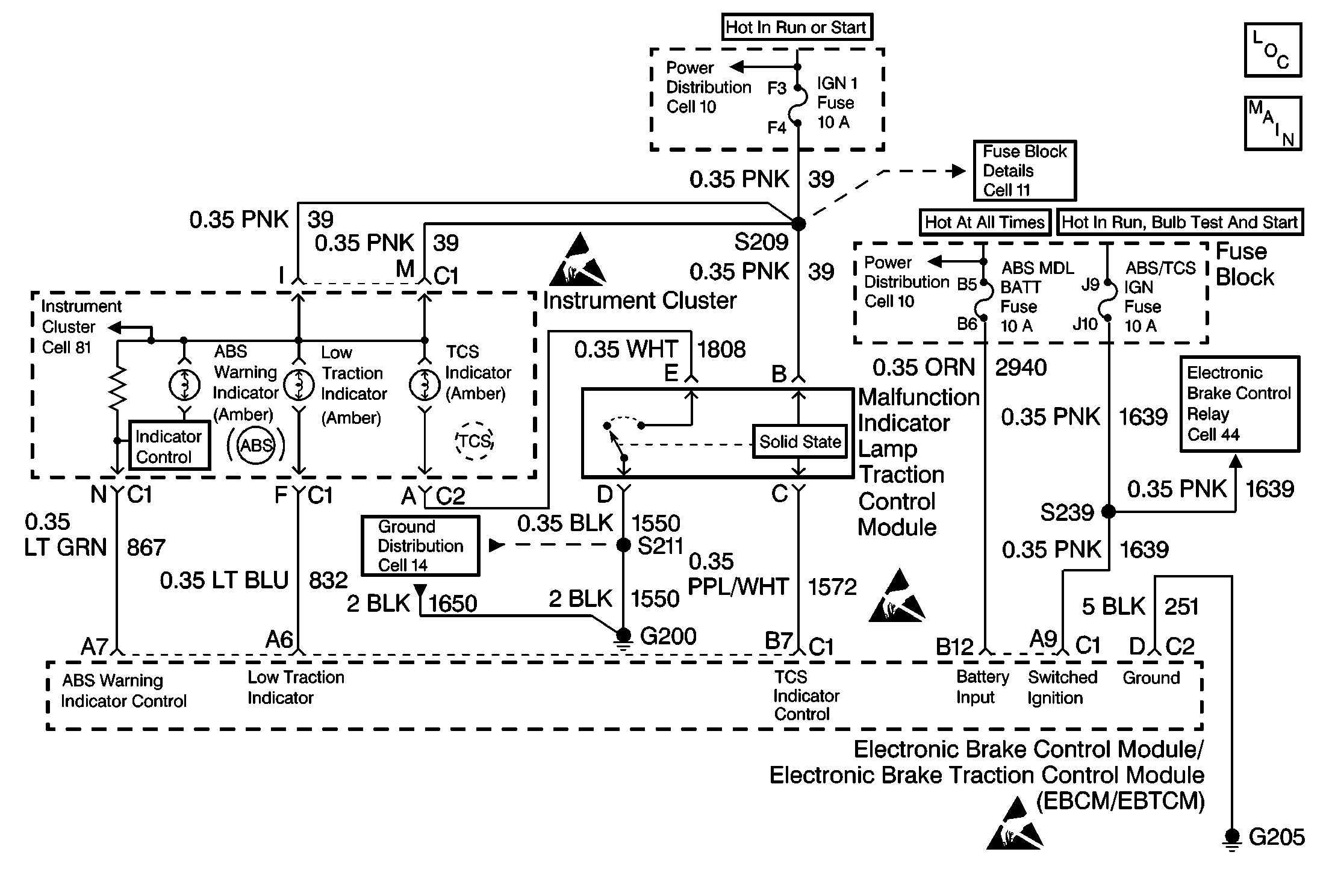
Circuit Description
This symptom table tests the state of the TCS warning indicator in order to identify either of the following conditions:
| • | The TCS warning indicator could not warn the driver of a system malfunction |
| • | The TCS warning indicator is always off |
The EBCM/EBTCM must provide a ground in order to turn the amber TCS warning indicator off because of Malfunction Indicator Lamp Control Module (lamp driver module) in the circuit. Because of the circuitry in the Lamp Driver Module (LDM), only external malfunctions can be detected. As a result, the LDM is not diagnosable. If CKT 1572 is open, the TCS warning indicator will remain on due to the loss of ground at the integral LDM input. If the control line is shorted to ground, the TCS warning indicator will remain off. The TCS warning indicator will remain off because the integral LDM input will be grounded. DTC C1311 will set if any of the following conditions exist:
| • | An open in CKT 1572 |
| • | A short to ground on CKT 1572 |
| • | A short to voltage in CKT 1572 |
Diagnostic Aids
Use the Lamp Test function of the Scan Tool in order to turn the indicator on while looking for an intermittent malfunction in the TCS warning indicator circuitry.
Thoroughly inspect any circuitry that may cause the intermittent complaint for the following conditions:
| • | Rubbed-through wire insulation |
| • | A broken wire inside the insulation |
| • | Backed out terminals |
| • | Improper mating |
| • | Broken locks |
| • | Improperly formed or damaged terminals |
| • | Poor terminal-to-wiring connections |
| • | Physical damage to the wiring harness |
Important: Zero the J 39200 test leads before making any resistance measurements.
Step | Action | Value(s) | Yes | No | ||||||||||||
|---|---|---|---|---|---|---|---|---|---|---|---|---|---|---|---|---|
1 | Was the Diagnostic System Check performed? | -- | Go to Step 2 | Go to Diagnostic System Check | ||||||||||||
2 |
Is the TCS indicator on? | -- | Go to Step 6 | Go to Step 3 | ||||||||||||
3 |
Is the TCS indicator on? | -- | Go to Step 4 | Go to Step 7 | ||||||||||||
4 |
Is the resistance within the specified range? | 0-2ohms | Go to Step 5 | Go to Step 10 | ||||||||||||
5 |
Is the voltage equal to or greater than the specified voltage? | 10V | Go to Step 12 | Go to Step 11 | ||||||||||||
6 |
Are there signs of poor terminal contact, terminal corrosion, or damaged terminals? | -- | Go to Step 13 | Go to Step 16 | ||||||||||||
7 |
Is the resistance within the specified range? | 0-2ohms | Go to Step 8 | Go to Step 14 | ||||||||||||
8 |
Is the voltage within the specified range? | 0-2V | Go to Step 9 | Go to Step 15 | ||||||||||||
9 | Inspect the instrument panel cluster connector for the following conditions:
Are there signs of poor terminal contact, terminal corrosion, or damaged terminals? | -- | Go to Step 13 | Go to Instrument Panel Cluster | ||||||||||||
10 | Repair the open or high resistance in CKT 1550. Is the repair complete? | -- | Go to Diagnostic System Check | -- | ||||||||||||
11 | Repair the open or high resistance in CKT 39. Is the repair complete? | -- | Go to Diagnostic System Check | -- | ||||||||||||
12 | Replace the Lamp Driver Module. Refer to Lamp Driver Module Replacement . Is the repair complete? | -- | Go to Diagnostic System Check | -- | ||||||||||||
13 | Replace all of the terminals that exhibit signs of poor terminal contact, terminal corrosion, or damaged terminal(s). Is the repair complete? | -- | Go to Diagnostic System Check | -- | ||||||||||||
14 | Repair the open or high resistance in CKT 1808. Is the repair complete? | -- | Go to Diagnostic System Check | -- | ||||||||||||
15 | Repair the short to voltage in CKT 1808. Is the repair complete? | -- | Go to Diagnostic System Check | -- | ||||||||||||
16 | Replace the EBCM/EBTCM. Refer to Electronic Brake and Traction Control Module Replacement . Is the repair complete? | -- | Go to Diagnostic System Check | -- |
